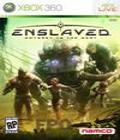The Journey to the West is a legendary story, considered one of the four great classical novels of Chinese literature. It tells the story of Son Wukong, a powerful and dangerous warrior who is forced to aid a monk in his journey. The story has been adapted in countless ways, some strict and others less so. Popular Japanese animated series Dragon Ball is actually an adaptation of Journey to the West, although the similarities between the two are slim. Enslaved: Odyssey to the West is loosely based on the characters and ideas from The Journey to the West, but in many ways, it is also its own beast.
Enslaved is set in the distant future. America is a postapocalyptic hellhole after an unspecified war. The few survivors eking out their existence in this wasteland are forced to contend with the mysterious Pyramid slavers, who use mechs and forcibly enlisted humans to capture more people for unknown purposes. Our story begins when a loner named Monkey is captured by the slavers. It looks bad for him until a girl named Tripitaka (or "Trip" for short) uses her technological skills to break free of the slavers' cell. Monkey also escapes in the confusion. Monkey and Trip find themselves in the middle of the desolate remains of New York City. Trip, 300 miles from home and utterly helpless, steals one of the slaver's headbands and places it on Monkey while he's asleep, forcing him to obey her commands or die. Without his help, Trip can't get home, and she isn't in a position to take "no" for an answer. Together, the duo sets off to find its way back to Trip's home and discover the Pyramid's plan. Along the way, they're joined by Pigsy, an obese junk dealer who is a dear friend of Trip's father. The trio will have get over their differences if they want to survive in this harsh world.
Enslaved's plot is mostly a vehicle for its characters, almost to a fault. The story is rather thin and seems like a halfhearted excuse to throw Monkey, Pigsy and Trip into situations where they can be wacky and interact. The enemy faction consists of faceless identical robots with very little presence or appeal. Pyramid's plan is so hackneyed that I imagine everyone will roll their eyes at the reveal. It's not just cliché; it's basically a copy of a certain popular movie franchise that everyone already knows. Tossing in a little Journey to the West doesn't change this, especially since it's severely underutilized. The plot is resolved in a last-minute cut scene, although it was nice to have a game that resolved its plot instead of setting up for an inevitable sequel.
Fortunately, the characters are likeable, although there's very little conflict between them. The entire point of the game is that Monkey is enslaved by Trip, but he doesn't seem to care. He makes one angry comment about it, and then he's pretty cool with the whole "turned into a slave" thing. He and Trip even joke about it within a few hours. Pigsy is the game's sole source of conflict, and he's not really that interesting of one. If this were a Hollywood movie, he'd be played by Steve Buscemi. He's crude, disgusting and selfish but not aggressive or dangerous, despite an odd attempt to kill Monkey. It feels like there should have been more done with Monkey as a character. He seems to go along with everything and never displays any further anger or frustration at his situation. It seems a little out of place.
Enslaved takes cinematic platforming to an extreme degree. In the 2008 version of Prince of Persia, you couldn't die. The platforming was strongly guided, and If you failed, you were rescued by another character. Enslaved is even more extreme than that. The game will not let you make a jump you can't complete, and you can never fall to your death or go in the wrong direction. For a large portion of the game, platforming is without threat, except for the occasional mechs shooting at you. The last quarter of the game introduces some dangerous obstacles, but they're still fairly minor. To get through a large portion of the game, aim your thumbstick roughly in the direction you need to go and pound on the jump button. Monkey will take care of all the climbing, jumping and moving, and you can get through much of the segments without even looking at the screen. When the more dangerous obstacles come up, you'll need to time when you press the button.
In some ways, this works to Enslaved's benefit. The strongest moments of the game are its fast-paced set pieces, where Monkey is swinging and climbing through a collapsing building or trying to keep up with a speeding car that is a moving shield against enemy fire. In these areas, the heavily guided platforming works. It helps keep things feeling cinematic and interesting, and it makes the game flow more like a movie while still giving players some interactivity. The last boss battle is basically an extended series of high-energy platforming segments. It is straightforward and perhaps goes on a little too long, but it shows off some of the strong points of Enslaved's guided platforming. There are also a few simple puzzles scattered here and there, but nothing will tax anyone's brainpower.
At a few points during the game, Monkey can activate his cloud, which is a hovering surfboard that Monkey can use to move around much more quickly. Since he's the only one who can ride it, he can't use it to bypass dangerous obstacles without leaving Trip behind. These cloud segments are the only time when you can move around freely and jump at any time. You still can't leap to your death, but at least the platforming is more involved. Most of these cloud segments involve Monkey traveling ahead of Trip in order to pull a switch or lever. A few require him to catch up with a fleeing mech in a racing minigame. You have to pull off some fast-paced platforming while hitting special speed boosts to catch up to the mech before it escapes. These segments are odd but reasonably fun, and they add a nice dose of high-speed platforming to the more guided sections.
Less exciting is the combat. Monkey occasionally has to fight robots, either at a distance or toe-to-toe. Theoretically, Monkey has a wide range of abilities. He can perform different combos using his extending rod or charge it up to stun enemies. He can also clear the area around him with a whirlwind strike, and he can block and evade enemy attacks. Unfortunately, combat is pretty lackluster. You pound the attack button over and over until an enemy blocks, at which point you charge and stun them. If you get surrounded, whirlwind knocks everything back for little to no cost. There's very little skill necessary for combat, but, unlike platforming, this doesn't add to the cinematic feel. Things can get more intense when a lot of enemies show up, but by that point, you'll have the pattern down so pat that you'll only take damage when the camera angles are working against you.
To the game's credit, it tries to do interesting things with flawed enemies. The mechs are not identical. Every so often, one comes off the production line with a flaw. Trip will mark these enemies with an icon for you. If you damage a flawed enemy enough, you can perform a takedown on it. These takedowns will destroy the foe and yield a benefit. For example, a foe with a damaged power core can be thrown into a crowd of enemies to destroy multiple foes. Another kind of mech with a built-in gun arm can have the arm ripped off and turned into a powerful weapon for a brief period of time. It's a neat idea, and if the combat were a little more involved, it could be something fun. Instead, it just serves as a way to make fights take slightly less time.
There's also some ranged combat in Enslaved, but it's even less enjoyable than the hand-to-hand stuff. Monkey's staff also doubles as a plasma launcher. You can fire deadly plasma bolts or EMP stun blasts from the end of the staff. While you can only carry a limited amount of ammo, you'll always find more if you need it for that section. There are cover mechanics, but they're pretty automated. If Monkey is near cover, he'll duck behind it. The problem with ranged combat in Enslaved is that two shots from your plasma rifle will kill any foe. If you upgrade the power of your staff, you won't even need two shots. It's perfectly accurate at any range, and there doesn't seem to be much need to aim precisely. The only wrinkle comes in the form of shielded foes, but defeating them is a matter of switching to Stun Blast, firing once, and then switching back to Plasma to finish them off. While fighting ranged enemies, Monkey also has a Halo-style shield system, which prevents him from taking health damage until it wears out. It's a neat idea but doesn't do much to make ranged combat more exciting.
Considering the premise, you'd expect that protecting Trip would be a big part of Enslaved, but it isn't. Early on, Monkey has to get Trip past obstacles and distract enemy fire so she can slip by. Trip has the ability to project a temporary distraction that allows Monkey to sneak up on foes. Enemy mechs find Trip a more tantalizing target then Monkey, and if possible, they rush after her and attempt to kill her. Trip can save herself once with a short-range EMP burst, but Monkey has to kill the robots before the EMP wears off, or Trip is toast. During the early segments, all of this is put to good effect. Monkey and Trip's skills complement each other, and the puzzles designed around them are fun.
After about the first quarter of the game, however, this teamwork starts to fade into the background. Trip is almost never in danger, and asking Trip for help becomes a rarity. Toward the end of the game, Monkey might as well be on his own. On the other hand, Trip basically doesn't need your help, aside from being thrown to a distant ledge or given a boost up. The escort and teamwork mechanics are completely forgotten, and it feels rather weird. Instead of progressively learning to work together more, the characters frequently separate and stop covering each other's weaknesses. On the plus side, it's nice to not have a game-long escort mission. On the minus side, it feels weird that more isn't done with the characters' partnership. There are a few puzzles, but they're incredibly simple, and Trip's usefulness there amounts to hitting a button.
One way that Trip remains useful throughout the game is by upgrading Monkey. You earn Tech Orbs by defeating foes or exploring the level. These orbs function as money that you can spend to have Trip power up Monkey's staff or personal shield. Powering up your Stun attack makes it hit multiple foes, and your staff's plasma shot damage can be doubled or quadrupled. You can even add health regeneration or improved shielding. My only complaint is that the game gives you a serious excess of tech points. Even without scouring every corner of the map, I had Monkey almost completely upgraded by the end of my playthrough. The only things I was lacking were near-useless abilities, such as increased firing rate for Monkey's staff. It's nice to not punish players who missed valuable orb caches, but it feels pointless to search every nook and cranny when you can get everything by playing normally.
Enslaved is a one-playthrough game. The story holds together reasonably well on a single playthrough, but it doesn't have enough meat to work a second time through. The flaws would become a lot more apparent without the shine of new set pieces to distract you from them. There are some collectables and higher difficulty levels, but nothing that adds to the experience. Enslaved can be finished in about eight hours, perhaps a little more if you really take the time to look around. It's not a bad length, but it may feel too short for most players.
Enslaved is an absolutely lovely game. The characters move with fluid grace, thanks in no small part to the motion capture done under the helm of award-winning motion capture artist Andy Serkis, who also plays the titular character Monkey. Some of the animations look a little stiff, but for the most part, the characters look great. Even more striking is the wonderful art design. Instead of the usual browns and grays of a postapocalyptic world, Enslaved has a colorful and vibrant world, which makes the destruction stand out more. It's a nice switch to see ruins that are something besides a mass of brown, and it gives the game some personality. On top of that, some of the set pieces are amazing to see. Having to escaping a crashing airship or battle a gigantic scorpion mecha while riding another, even bigger mecha lends the game a real sense of epic awe. However, I did notice that there was some pretty bad frame rate drop in the game's busier sections, sometimes slowing things down to a crawl.
The voice acting in Enslaved is quite good. There are only three primary characters in the story, and aside from a few minor voices, they do most of the work. It took me a little while to get used to Serkis' Monkey, but he has a gruff charm that is difficult to deny. Richard Ridings' Pigsy seemed to waver in and out of his accent, but it was only a minor distraction. Lindsey Shaw's Trip is perfect for the role and manages to make Trip's innocence feel natural without being overdone. Ninin Sawheny's soundtrack is top-notch, and the songs fit the mood quite often, without overshadowing the voice actors' work. As far as the overall presentation goes, it's hard to find much fault with Enslaved.
Enslaved: Odyssey to the West is perhaps one of the best examples I've seen of a rental game. The platforming is simplistic, and most of the time, combat is a one-button affair. Despite this, the set pieces are impressive, the characters are likeable, and the visuals are quite good. In many ways, Enslaved would stand better as a movie instead of a video game. It's certainly worth playing through at least once, and the top-notch visuals and soundtrack help you overlook the game's flaws. Despite this, it's extremely difficult to recommend buying the game at full price. Enslaved is a solid way to waste a weekend, but it lacks the depth to be anything more.
Score: 7.5/10
More articles about Enslaved: Odyssey to the West










 A tactical action-adventure game, Enslaved centers on the complex relationship between the two main characters and challenges players to employ a mix of combat, strategy and environment traversal.
A tactical action-adventure game, Enslaved centers on the complex relationship between the two main characters and challenges players to employ a mix of combat, strategy and environment traversal.








































